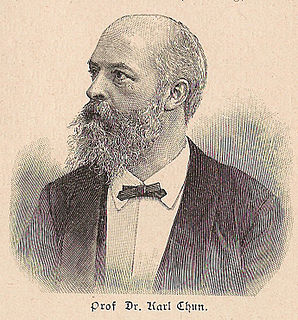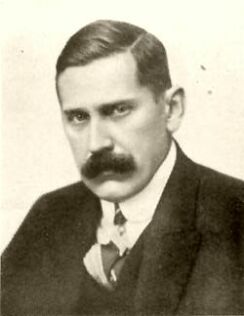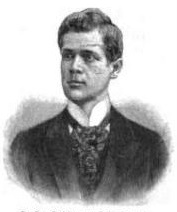Related Research Articles

Ludwig Joseph Brentano was an eminent German economist and social reformer.

Karl Hermann Johannes Thiele was a German zoologist specialized in malacology. Thiele was born in Goldap, East Prussia. His Handbuch der systematischen Weichtierkunde is a standard work. From 1904 until his retirement in 1925 he was the curator of the malacological collection at the Museum für Naturkunde in Berlin. Thiele described more than 1.500 new species of molluscs; until today their types are deposited with the Museum of Natural History in Berlin. Especially important are his works on the Mollusca of the First German Antarctica Expedition and of the German Deep Sea Expedition aboard the vessel Valdivia.

Carl Chun was a German marine biologist.
Karl Gegenbaur was a German anatomist and professor who demonstrated that the field of comparative anatomy offers important evidence supporting of the theory of evolution. As a professor of anatomy at the University of Jena (1855–1873) and at the University of Heidelberg (1873–1903), Karl Gegenbaur was a strong supporter of Charles Darwin's theory of organic evolution, having taught and worked, beginning in 1858, with Ernst Haeckel, eight years his junior.

Othenio Lothar Franz Anton Louis Abel was an Austrian paleontologist and evolutionary biologist. Together with Louis Dollo, he was the founder of "paleobiology" and studied the life and environment of fossilized organisms.

The Gauss expedition of 1901–1903 was the first German expedition to Antarctica. It was led by geologist Erich von Drygalski in the ship Gauss, named after the mathematician and physicist Carl Friedrich Gauss.

Heinrich Claß was a German right-wing politician, a Pan-Germanist, an anti-Semite and a "rabid racialist". He presided the Pan-German League from 1908 to 1939.
Jacob Caro was a German historian.
Otto Schrader was a German philologist best known for his work on the history of German and Proto-Indo-European vocabulary dealing with various aspects of material culture, such as the names of domesticated plants and animals, the names of the metals, etc.
Eberhard Fraas was a German scientist, geologist and paleontologist. He worked as a curator at the Stuttgarter Naturaliensammlung and discovered the dinosaurs of the Tendaguru formation in then German East Africa. The dinosaur Efraasia is named after him.
Heinrich Hermann Robert Hartmeyer was a German zoologist.

Carl Heinrich Apstein was a German zoologist and botanist. The standard author abbreviation Apstein is used to indicate this person as the author when citing a botanical name.
Erich Wagler was a German ichthyologist and malacologist.

Otto Karl Ladislaus zur Strassen was a German zoologist. An advocate of Darwinism, his primary focus was concerned with biological morphology and developmental mechanics.

Samuel Lublinski was a Berlin-based writer, literary historian, critic, and philosopher of religion. He was a pioneer of the socio-historical study of literary movements and a major contributor to the debates about German-Jewish national and cultural identity of the era.
Johannes Kromayer was a German classical historian. He was an older brother of dermatologist Ernst Kromayer (1862–1933).
Oswald Seeliger was a German zoologist, known for his studies involving the anatomy and developmental history of tunicates.
Heinrich Bergner was a German art historian and Protestant pastor.
Richard Arthur Hans Kummerlöwe, with the spelling changed to Kumerloeve from 1948 was a German ornithologist who served as an SS Officer during the Second World War. He initially worked as a zoological curator at the Dresden Museum but during the Third Reich he held numerous positions including charge of the Vienna museum after the German annexation of Austria in March 1938. He was involved in the "Nazification" of German and Austrian museums, making them tools for explaining theories of race and genetic purity.

Karl Otto Heinrich Liebmann was a German mathematician and geometer.
References
- 1 2 (in German) "Prof. Dr. phil. Johannes Meisenheimer". Professorenkatalog der Universität Leipzig. Catalogus professorum lipsiensis. accessed 1 February 2011.